The Enterprise Feedback Management Market is estimated to be valued at USD 3.2 billion in 2025 and is projected to reach USD 16.7 billion by 2035, registering a compound annual growth rate (CAGR) of 17.7% over the forecast period.
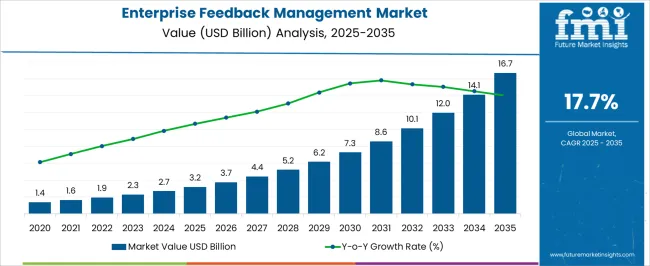
| Metric | Value |
|---|---|
| Enterprise Feedback Management Market Estimated Value in (2025 E) | USD 3.2 billion |
| Enterprise Feedback Management Market Forecast Value in (2035 F) | USD 16.7 billion |
| Forecast CAGR (2025 to 2035) | 17.7% |
The enterprise feedback management market is expanding steadily, fueled by the growing importance of customer insights in strategic decision-making and operational improvement. Organizations are increasingly investing in digital platforms that capture, analyze, and act on feedback collected across multiple touchpoints.
Rising demand for customer-centric business models, coupled with advancements in data analytics and AI-driven sentiment analysis, is propelling adoption. The current landscape is shaped by heightened competition across industries, where actionable feedback is viewed as a critical differentiator.
Enterprises are leveraging these systems not only to improve customer experience but also to strengthen employee engagement and streamline operations. The future outlook remains positive as businesses prioritize continuous improvement, regulatory compliance, and personalized engagement strategies.
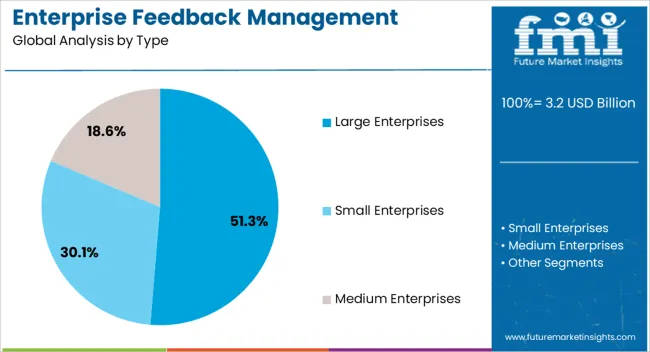
The large enterprises segment leads the type category, holding approximately 51.3% share of the enterprise feedback management market. This dominance is underpinned by the extensive resources and customer bases of large organizations, which necessitate structured systems for managing complex feedback channels.
Large enterprises often operate across multiple geographies and service lines, creating high demand for scalable, centralized feedback solutions. Adoption has been reinforced by the integration of AI and advanced analytics, enabling enterprises to convert feedback into actionable intelligence.
With ongoing digital transformation initiatives and the prioritization of customer experience as a strategic asset, large enterprises are expected to sustain their leadership in the market.
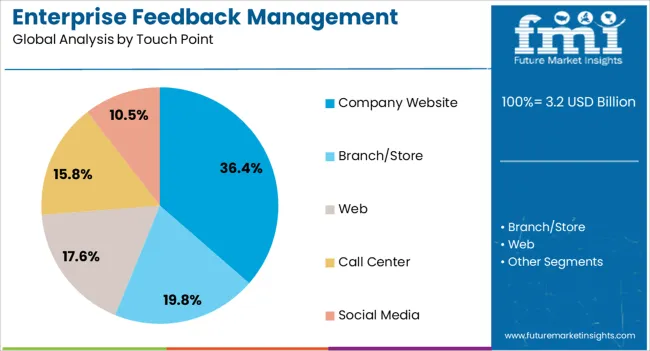
The company website segment dominates the touchpoint category with approximately 36.4% share, driven by its role as the primary digital interface between businesses and customers. Organizations rely on websites to capture real-time feedback on products, services, and overall user experience.
The segment’s prominence is supported by increasing online traffic, digital-first engagement strategies, and ease of integrating survey and analytics tools. Enhanced data security and customization options further strengthen adoption.
As digital interactions continue to expand globally, company websites will remain a leading feedback touchpoint for enterprises aiming to improve responsiveness and customer satisfaction.
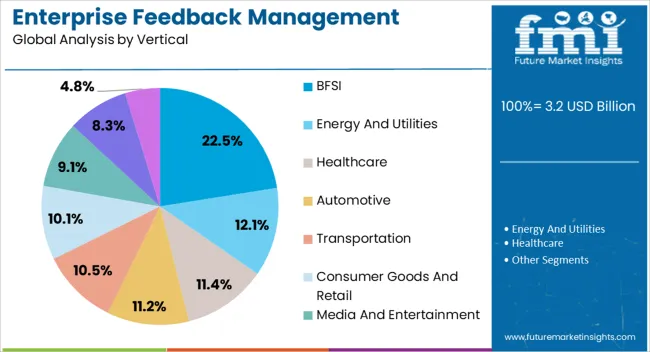
The BFSI segment holds approximately 22.5% share in the vertical category of the enterprise feedback management market. The sector’s reliance on trust, security, and customer satisfaction makes feedback management systems critical for maintaining competitiveness.
Financial institutions are leveraging structured platforms to monitor customer sentiment, ensure compliance, and enhance service delivery. The segment benefits from high digital adoption in banking and insurance, where online platforms generate extensive feedback data.
Continuous innovation in fintech and the push for customer-centric models further reinforce demand. With growing regulatory scrutiny and the importance of customer loyalty in financial services, the BFSI segment is expected to remain a leading vertical in the market.
| Attributes | Details |
|---|---|
| Trends |
|
| Opportunities |
|
The increasing adoption of EFM software is escalating concerns over security and data theft. As the incidences of privacy issues and cybersecurity increase in these solutions and other digital tools, the sales of EFM are anticipated to be negatively impacted. On top of this, cloud-based feedback management solutions are being significantly adopted, thereby raising the risk of privacy concerns and data security. These attacks can come in different forms and can result in various losses like customer and business data.
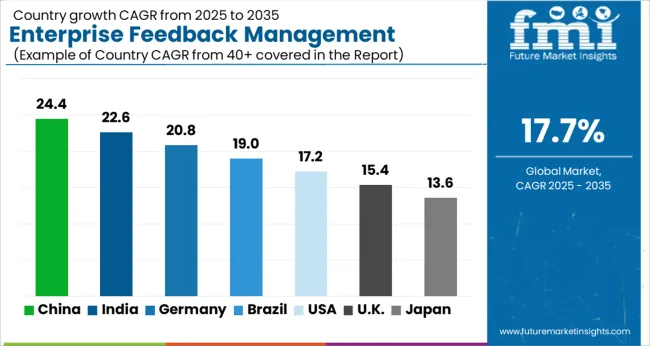 In North America, the rapid adoption of next-generation innovations like AI, IoT, machine learning, and big data analytics are enhancing the market scope of enterprise feedback management (EFM) systems. This is because these technologies help procure important insights from multiple feedback datasets. Similarly, in Europe, the adoption of EFM is expected to remain strong over the forecast period due to a high level of willingness to optimize operations systems.
In North America, the rapid adoption of next-generation innovations like AI, IoT, machine learning, and big data analytics are enhancing the market scope of enterprise feedback management (EFM) systems. This is because these technologies help procure important insights from multiple feedback datasets. Similarly, in Europe, the adoption of EFM is expected to remain strong over the forecast period due to a high level of willingness to optimize operations systems.
Countries in the Asia Pacific are predicted to expand at a remarkable pace, as these countries are relatively new to the enterprise feedback management software and tools and showcase robust economic conditions for leading vendors to flourish.
Deployment of enterprise feedback management is predicted to expand at an impressive CAGR of 14.90% through 2035. Growth in the next ten years is predicted to increase due to:
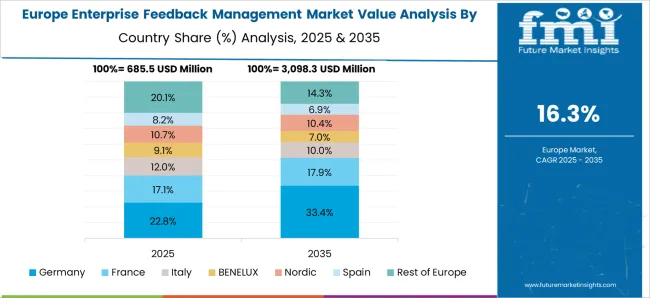
Demand for enterprise feedback management is expected to surge at a CAGR of 17.50% through 2035. The following factors are propelling the market growth:
In China, the vendors of enterprise feedback management are finding a growth of 18.60% through 2035. Over the forecast period, the market is predicted to be driven by:
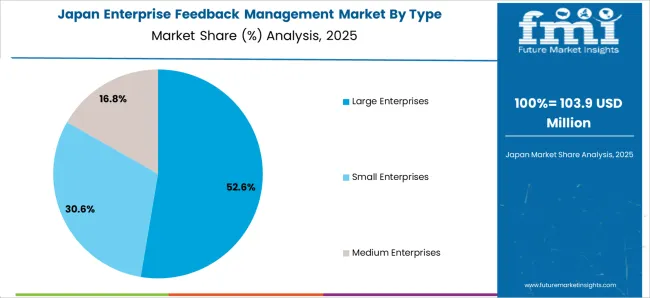
The adoption of enterprise feedback management is predicted to intensify in Japan at an excellent CAGR of 19.30% through 2035. Key factors driving the market growth are as follows:
In Australia, the deployment of enterprise feedback management services is rising at a pace of 21.60% through 2035. The market is driven by:
| Attributes | Details |
|---|---|
| Top Type | Large Enterprises |
| Market Share in 2025 | 51.3% |
As per a recent enterprise feedback management market report, the large enterprises segment is predicted to acquire a massive 51.3% in 2025. This segment is projected to hold its dominance owing to:
| Attributes | Details |
|---|---|
| Top Touch Point | Web |
| Market Share in 2025 | 28.4% |
The web segment is projected to capture a share of 28.40% in 2025. The segment is driven by factors like:
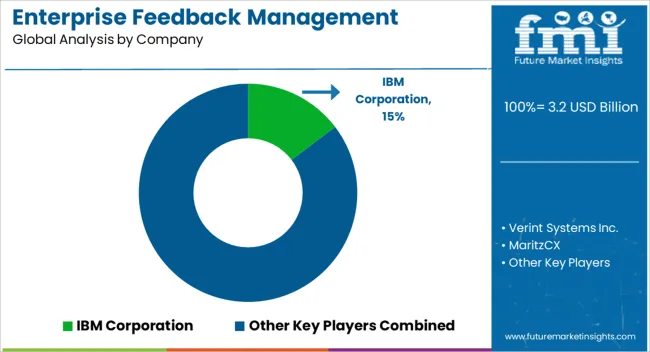
Recent Development in Enterprise Feedback Management Market
| Report Attributes | Details |
|---|---|
| Current Total Market Size (2025) | USD 2.68 billion |
| Projected Market Size (2035) | USD 14.10 billion |
| CAGR (2025 to 2035) | 18.1% |
| Base Year for Estimation | 2025 |
| Historical Period | 2020 to 2025 |
| Projections Period | 2025 to 2035 |
| Market Analysis Parameter | Revenue in USD billion |
| By Type | Small Enterprises, Medium Enterprises, Large Enterprises |
| By Touch Point | Company Website, Branch/Store, Web, Call Center, Social Media |
| By Verticals | Energy & Utilities, BFSI, Healthcare, Automotive, Transportation, Consumer goods & Retail, Media & Entertainment, Hospitality, Manufacturing |
| Regions Covered | North America, Latin America, Western Europe, Eastern Europe, South Asia and Pacific, East Asia, Middle East and Africa |
| Countries Covered | United States, Japan, Germany, India, United Kingdom, France, Italy, Brazil, Canada, South Korea, Australia, Spain, Netherlands, Saudi Arabia, Switzerland |
| Key Players | IBM Corporation, Verint Systems Inc., MaritzCX, MirrorWave, Qualtrics, LLC, Ipsos SA, InMoment, Inc., Cvent, Inc., Confirmit, Inc., Ambivista |
| Additional Attributes | Rising demand for cost-effective dairy alternatives, growing infant nutrition sector, expanding bakery industry |
| Customization and Pricing | Available upon request |
The global enterprise feedback management market is estimated to be valued at USD 3.2 billion in 2025.
The market size for the enterprise feedback management market is projected to reach USD 16.7 billion by 2035.
The enterprise feedback management market is expected to grow at a 17.7% CAGR between 2025 and 2035.
The key product types in enterprise feedback management market are large enterprises, small enterprises and medium enterprises.
In terms of touch point, company website segment to command 36.4% share in the enterprise feedback management market in 2025.






Full Research Suite comprises of:
Market outlook & trends analysis
Interviews & case studies
Strategic recommendations
Vendor profiles & capabilities analysis
5-year forecasts
8 regions and 60+ country-level data splits
Market segment data splits
12 months of continuous data updates
DELIVERED AS:
PDF EXCEL ONLINE
Enterprise Feedback Management Industry Analysis in Western Europe Size and Share Forecast Outlook 2025 to 2035
Enterprise Feedback Management Industry Analysis in Korea Size and Share Forecast Outlook 2025 to 2035
Enterprise Feedback Management Industry Analysis in Japan Size and Share Forecast Outlook 2025 to 2035
Enterprise A2P SMS Market Size and Share Forecast Outlook 2025 to 2035
Enterprise-Class Hybrid Storage Market Size and Share Forecast Outlook 2025 to 2035
Enterprise Social Graph Market Size and Share Forecast Outlook 2025 to 2035
Enterprise File Sync And Share Platform Market Size and Share Forecast Outlook 2025 to 2035
Enterprise Mobility Market Size and Share Forecast Outlook 2025 to 2035
Enterprise LLM Market Size and Share Forecast Outlook 2025 to 2035
Enterprise VSAT Systems Market Size and Share Forecast Outlook 2025 to 2035
Enterprise AI Governance and Compliance Market Analysis - Size, Share, and Forecast Outlook 2025 to 2035
Enterprise Resource Planning (ERP) Software Market Size and Share Forecast Outlook 2025 to 2035
Enterprise IoT Market Size and Share Forecast Outlook 2025 to 2035
Enterprise WLAN Market Size and Share Forecast Outlook 2025 to 2035
Enterprise Network Equipment Market Size and Share Forecast Outlook 2025 to 2035
Enterprise Social Networks Market Size and Share Forecast Outlook 2025 to 2035
Enterprise Video Market Analysis - Size, Share, and Forecast 2025 to 2035
Enterprise-Grade DLT Market Size and Share Forecast Outlook 2025 to 2035
Enterprise Information Archiving (EIA) Market Size and Share Forecast Outlook 2025 to 2035
Enterprise Manufacturing Intelligence Market Analysis by Deployment Type, Offering, End-use Industry, and Region Through 2035

Thank you!
You will receive an email from our Business Development Manager. Please be sure to check your SPAM/JUNK folder too.
Chat With
MaRIA